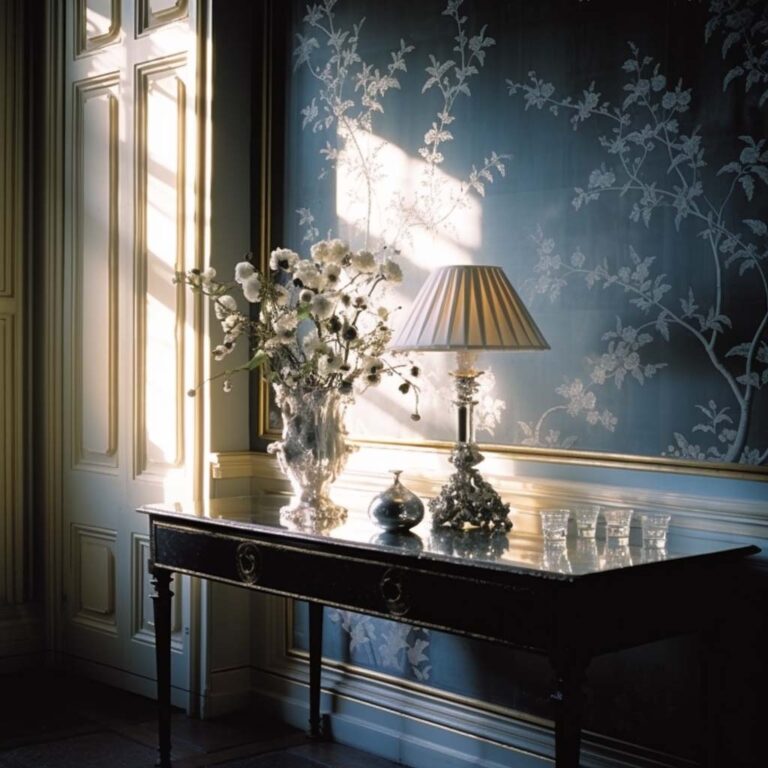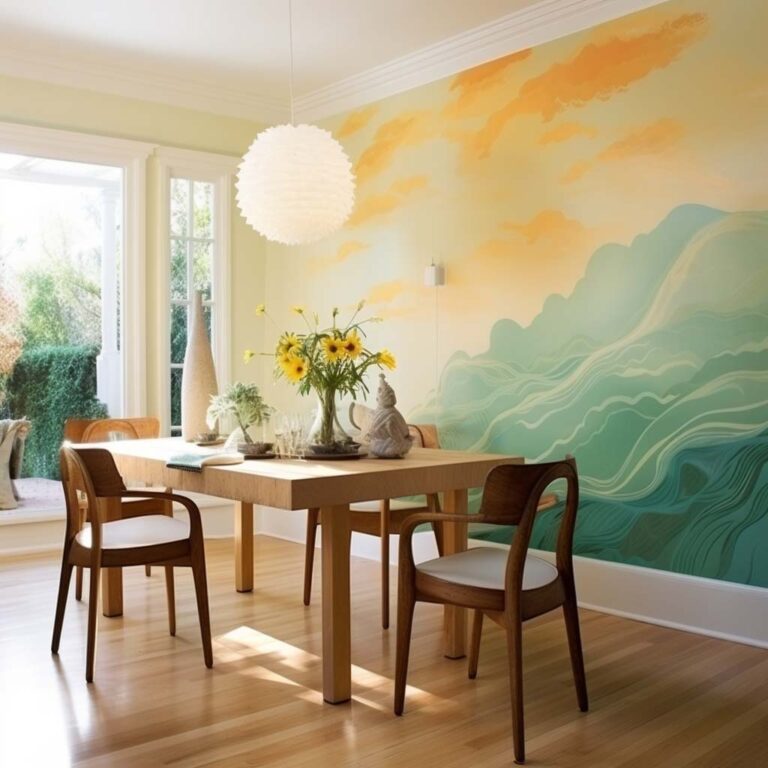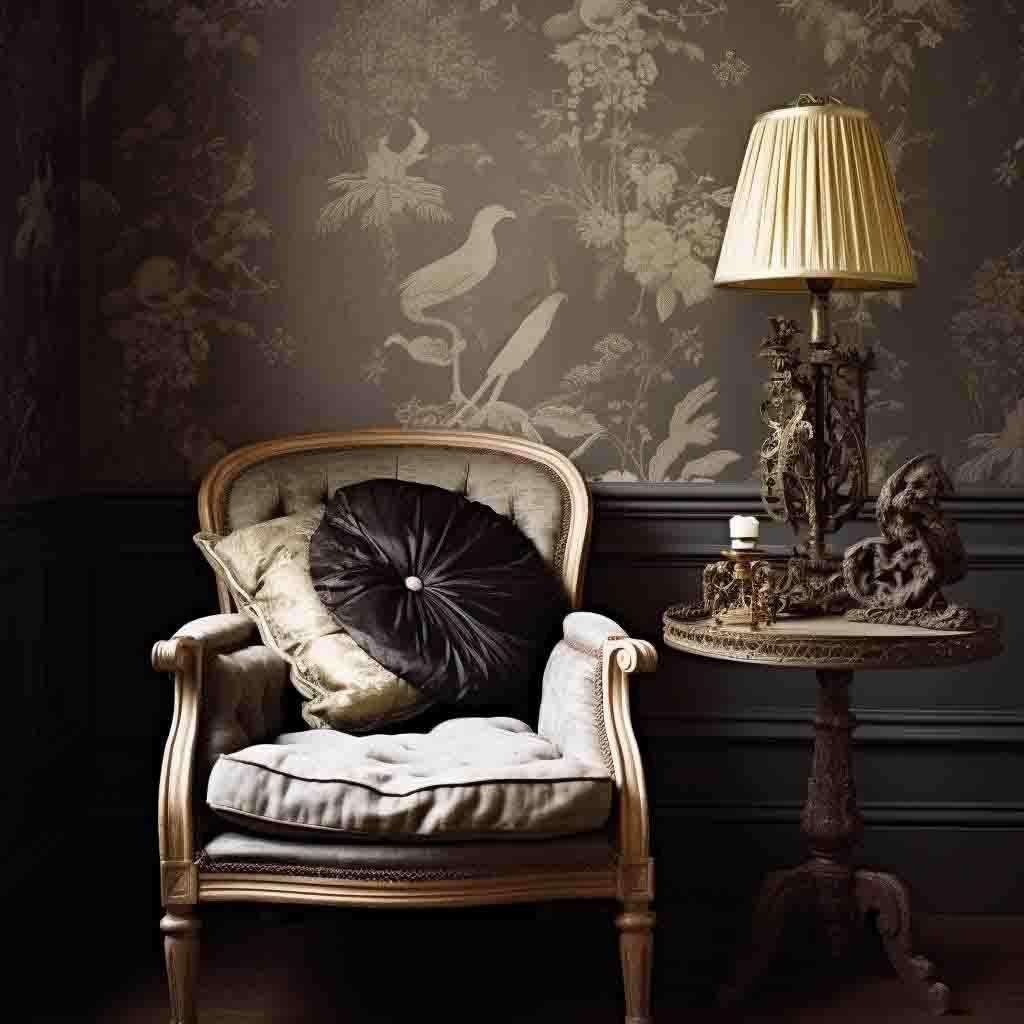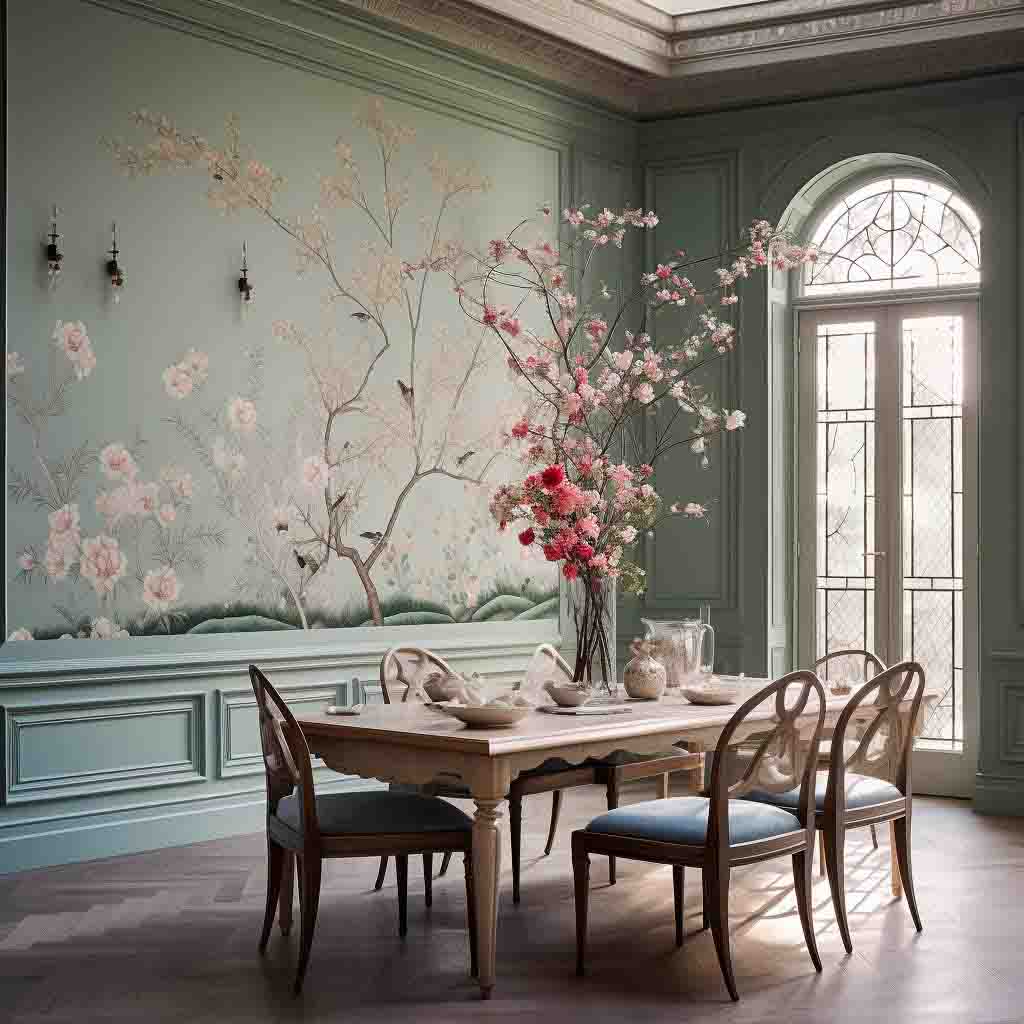Designer tips for combining wallpapers with other interior elements
Achieving a harmonious interior involves more than just selecting appealing wallpapers; it’s about integrating them seamlessly with other design elements. Let’s take a look at the designer tips for combining wallpapers with other interior elements!
Table of Contents
Toggle




1. Color coordination:
- Tone-on-Tone Elegance: Achieve a sophisticated look by selecting wallpapers that closely match or harmonize with the dominant color palette in your interior. This subtle approach creates a cohesive and timeless ambiance.
- Contrasting Statements: For a bold and attention-grabbing effect, opt for wallpapers with contrasting colors against the room’s existing color scheme. This can serve as a focal point or an accent wall, adding depth and visual interest to the space.
- Complementary Accents: Infuse vitality into your design by incorporating complementary colors from the color wheel. Choose wallpapers that feature accents or undertones that resonate with other elements in the room, such as furniture or accessories, creating a well-balanced and harmonious composition.
2. Texture and pattern mix:
- Subtle Texture Layering: Achieve a harmonious blend by combining wallpapers with different textures and patterns. Consider using one wallpaper as a subdued backdrop with a subtle texture, while the other introduces a complementary pattern with slight contrast, resulting in an elegant and cohesive look.
- Bold Pattern Fusion: For a more daring and eclectic design, experiment with pairing wallpapers featuring bold textures and patterns. Select wallpapers that complement each other’s textures and patterns, creating a dynamic and visually captivating interplay.
- Transitional Continuity: To maintain a seamless transition between rooms or spaces, choose wallpapers that share a common element, such as a color, texture, or pattern theme. This transitional approach ensures a sense of flow while allowing each area to maintain its unique character.
3. Furniture and wallpaper harmony:
- Color Cohesion: Opt for furniture pieces that either complement or contrast with the colors in the wallpaper. Harmonize by selecting furniture in shades that echo those found in the wallpaper, or create a captivating focal point by choosing contrasting colors for a bold statement.
- Pattern Play: Ensure the patterns on your furniture and wallpaper work together harmoniously. Strive for a balance between busy patterns and more understated designs. If the wallpaper boasts a bold pattern, consider furniture with a simpler, complementary pattern or solid upholstery to prevent overwhelming the space.
- Texture and Material Consistency: Maintain consistency in the textures and materials of both your furniture and wallpaper. For example, if your wallpaper features a tactile texture like grasscloth, pair it with furniture made from natural materials like wood or rattan for a cohesive and tactile experience.
4. Lighting considerations:
- Enhancing Texture and Detail: To emphasize the texture and intricate details of your wallpaper, choose lighting fixtures that provide focused illumination. Recessed spotlights or wall-mounted fixtures can help bring out the richness of textured wallpapers and highlight their unique patterns.
- Balanced Color Temperature: Maintain a harmonious atmosphere by considering the color temperature of your lighting. Warm-colored wallpapers can benefit from warm white or soft yellow lighting, while cooler-toned wallpapers pair well with cool white or daylight-balanced lighting, ensuring a cohesive color scheme.
- Layered Lighting Effects: Create depth and mood in your space by employing a layered lighting approach. Combine ambient, task, and accent lighting to illuminate various aspects of the room and adapt the lighting according to different activities and occasions.
5. Open floor plans and transition:
- Continuous Color Palette: In open floor plans, maintain a continuous color palette throughout the space. Choose wallpapers with colors that transition smoothly from one area to another, ensuring a cohesive and unifying look.
- Zoning with Patterns: Utilize wallpapers strategically to define different zones within an open space. Consider using distinct wallpaper patterns or textures to visually separate areas like the living room, dining area, and kitchen while maintaining an overall sense of flow.
- Transitioning Techniques: When transitioning between spaces with different wallpapers, employ design techniques to make the change feel deliberate. For example, use architectural elements like archways, molding, or wainscoting as transition points, allowing the wallpapers to meet and complement each other at these junctures.
6. Wall height and proportions:
- Embrace Verticality: To enhance the sense of height in a space with lower ceilings, opt for wallpapers that feature vertical stripes or patterns. These patterns draw the eye upward, creating an illusion of increased wall height and a more expansive atmosphere.
- Proportionate Patterns: Maintain balance by considering the scale of wallpaper patterns in relation to the wall size. In larger rooms, use wallpapers with larger motifs or patterns to fill the space effectively, while in smaller areas, choose smaller-scale patterns to prevent overwhelming the room.
- Accentuate Architectural Features: Make the most of architectural elements, such as moldings, wainscoting, or panels, to break up the wallpapered surfaces. These features can provide natural divisions and proportions, adding depth and visual interest to the walls.
7. Room purpose and wallpaper selection:
- Reflect Functionality: Tailor your wallpaper choice to the intended function of the room. For tranquil spaces like bedrooms or libraries, opt for calming and understated patterns or textures. In more active areas like living rooms or dining rooms, consider wallpapers that add vibrancy and energy.
- Ambiance Enhancement: Use wallpaper to set the desired mood in a room. In spaces meant for relaxation, select soothing color palettes and gentle patterns to create a serene atmosphere. For entertaining or socializing areas, embrace bolder colors and patterns to make a design statement.
- Multi-Purpose Adaptability: In rooms with diverse functions, choose versatile wallpapers that can complement various purposes. Opt for neutral or adaptable patterns that allow for easy customization through furniture, decor, and lighting choices.
Explore our four main services and make the right decision to start cooperating with us. Choose professionals and get high-quality services. We are proud of the trust of our clients and appreciate mutually beneficial cooperation! Contact us and get to know our approach to each client!
Conclusion:
By integrating these design principles, you’ll be able to create a cohesive and visually pleasing interior where wallpapers work in harmony with furniture, lighting, accessories, and the room’s overall ambiance. The goal is to achieve a balanced and thoughtfully curated environment that showcases your personal style. Helping you choose wallpaper: wallquest, thibautdesign, yorkwallcoverings, brewsterwallcovering, farrow-ball and other suppliers and manufacturers you can easily find online.
-
How to evaluate a wallpaper installer's work
-
Rasch wallpaper: Benefits and features
-
Choosing the right wallpaper size for your space
-
Caution: Heat and peel and stick wallpaper!
-
Meeting your wallpaper installer: How to be prepared
-
Wallpaper for kitchen island
-
Paper wallpaper
-
Peel and stick wallpaper
-
Nursery wallpaper
-
Removable wallpaper
-
How to select wallpaper for every room
-
Bring your home to life with flower wallpaper
-
How to choose and use white wallpaper
-
Coastal & Nautical Wallpaper
-
Pink Wallpaper
-
Preppy Wallpaper
-
Wallpaper hanging
-
Wood veneer wallcovering
-
Wallpapered ceiling
-
Gucci wallpaper: luxury and style
-
Dark wallpaper is a trend in interior design
-
7 steps to perfect wallpaper
-
Wallpaper in small bathrooms
-
Wallpaper as the key to furniture's second life
-
Personalized wallpaper
-
Kitchen wallpaper
-
Wallpaper installation near me
-
Can you put wallpaper on textured walls
-
Wallpaper for all seasons: adapting to year-round style
-
Bathroom wallpaper: waterproof solutions
-
The art of reviving vintage wallpaper: nostalgic chic
-
Kids' room magic: creative wallpaper ideas for children
-
The Versatility of Metallic Wallpaper: Shimmer and Shine
-
Milton and King wallpaper elegance
-
Accent wall ideas
-
How to install vinyl wallpaper?
-
Ideas for dog rooms
-
Wallpaper installation: DIY or hire professionals?
-
Interior design of dining area
-
Wallpapers vs paint: Pros and Cons for Your Home
-
Best living room wallpaper: inspiration and style
-
The art of transforming spaces
-
Individualized design
-
The psychology of color
-
Tips for choosing lighting
-
Unveiling the world of 3D wall murals
-
Mastering wallpaper installation
-
Unveiling the World of Wallpaper
-
Selecting a contractor
-
American wallpaper manufacturers
-
The artistry of expertise
-
Architect's advice on wallpapers...
-
Secrets of choosing a color palette for wallpaper and decorative plaster
-
DIY wallpaper application: art and practice
-
Trends in wallpaper design
-
Designer tips for combining wallpapers
-
Wallpapers in commercial spaces
-
Wallpaper as a decorative element...
-
Using wallpaper to create a specific mood
-
The history of wallpaper: from the past to the present
-
The art of combining wallpapers and accessories
-
Choosing wallpaper colors and patterns for different rooms
-
Creating accent walls
-
Wallpapers and decorative plasters in modern minimalism
-
Eco wallpapers and decorative materials
-
Taking care of wallpapers and decorative plasters
-
Top designer trends
-
Choosing and selecting wallpapers:...
-
Wallpapers: elevate your interiors with style and elegance
-
The importance of properly preparing walls
-
Challenges of installing prepasted wallpaper
-
Challenges of installing grasscloth wallpaper
-
Problems with installing peel and stick wallpaper
-
Problems of installing vinyl wallpapers on textured walls
